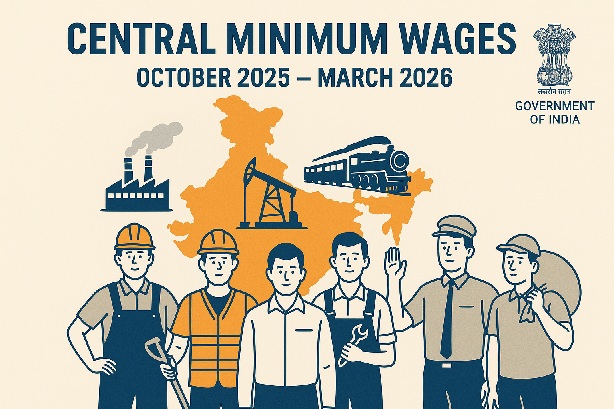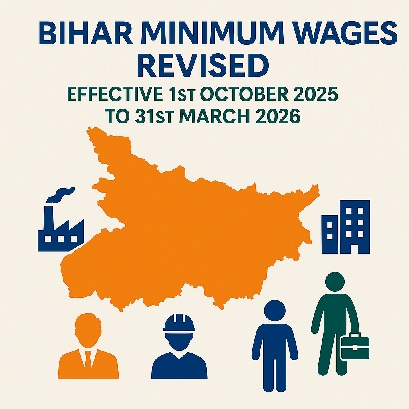
The Central Government has revised the minimum wages applicable to employments under its purview, effective from 1st October 2025 to 31st March 2026. This revision, notified by the Office of the Chief Labour Commissioner (Central), covers scheduled employments such as construction, mines, oilfields, railways, and central public sector establishments, and acts as a benchmark for several states as well.
This article explains the latest updates, effects, and compliance requirements in detail for employers and employees.
📌 Key Highlights of the Wage Revision
- Effective Period: 1st October 2025 – 31st March 2026
- Coverage: Central sphere employments (inter-state workers, contract workers, railway employees, mines, etc.)
- Components: Basic Minimum Wage + Variable Dearness Allowance (VDA)
- Frequency of Revision: Twice a year (April & October), linked to the Consumer Price Index (CPI-IW)
✅ Benefits & Positive Impacts
- Improved Worker Welfare
Workers in the lowest income bracket will see higher take-home pay, improving living standards and reducing dependency on debt. - Reduction in Wage Inequality
By raising the floor wage, the gap between low-wage and mid-wage earners reduces, thereby helping income equity. - Boost in Consumption Demand
Since low-wage workers spend a larger share of their earnings, higher wages will stimulate local markets. - Social Security Contributions
With higher wages, contributions under EPF, ESIC, Bonus, and Gratuity also increase, ensuring better long-term security.
⚠️ Challenges for Employers
- Higher Compliance Costs
Employers will need to adjust payroll, leading to higher wage bills and associated statutory contributions. - Risk of Informalisation
Some establishments may try to bypass compliance by pushing workers into informal arrangements. - Inflationary Pressure
Rising labour costs could translate into price hikes in certain labour-intensive industries. - Enforcement Gaps
Non-compliance is a risk, especially in small contractors and subcontracted employments.
📌 Compliance Checklist for Employers
- Revise wage structures in line with the notified minimum wages.
- Update payroll systems to reflect changes in Basic + VDA.
- Ensure statutory contributions (PF, ESIC, Bonus, LWF, PT, Gratuity) are recalculated on revised wages.
- Communicate the changes transparently to employees.
- Maintain updated wage registers and muster rolls for inspection.
🔎 Broader Implications (Oct 2025 – Mar 2026)
- For Workers: Direct rise in wages and social security benefits.
- For Employers: Higher labour costs but potential productivity gains if managed efficiently.
- For Economy: Positive impact on aggregate demand, but watch for inflationary pressures.
- For Compliance Professionals: Increased demand for accurate payroll & statutory management.
🏁 Conclusion
The Central Government’s minimum wage revision (Oct 2025 – Mar 2026) reinforces the importance of fair wages, worker welfare, and statutory compliance. While it brings undeniable benefits to workers, it also challenges employers to restructure costs and maintain compliance discipline.
Employers are advised to review wage structures, consult compliance experts, and adopt transparent practices to ensure smooth implementation. Workers, on the other hand, should remain informed of their rights to fair wages and timely social s
The Central Government has revised the minimum wages applicable to employments under its purview, effective from 1st October 2025 to 31st March 2026. This revision, notified by the Office of the Chief Labour Commissioner (Central), covers scheduled employments such as construction, mines, oilfields, railways, and central public sector establishments, and acts as a benchmark for several states as well.
This article explains the latest updates, effects, and compliance requirements in detail for employers and employees.
📌 Key Highlights of the Wage Revision
- Effective Period: 1st October 2025 – 31st March 2026
- Coverage: Central sphere employments (inter-state workers, contract workers, railway employees, mines, etc.)
- Components: Basic Minimum Wage + Variable Dearness Allowance (VDA)
- Frequency of Revision: Twice a year (April & October), linked to the Consumer Price Index (CPI-IW)
✅ Benefits & Positive Impacts
- Improved Worker Welfare
Workers in the lowest income bracket will see higher take-home pay, improving living standards and reducing dependency on debt. - Reduction in Wage Inequality
By raising the floor wage, the gap between low-wage and mid-wage earners reduces, thereby helping income equity. - Boost in Consumption Demand
Since low-wage workers spend a larger share of their earnings, higher wages will stimulate local markets. - Social Security Contributions
With higher wages, contributions under EPF, ESIC, Bonus, and Gratuity also increase, ensuring better long-term security.
⚠️ Challenges for Employers
- Higher Compliance Costs
Employers will need to adjust payroll, leading to higher wage bills and associated statutory contributions. - Risk of Informalisation
Some establishments may try to bypass compliance by pushing workers into informal arrangements. - Inflationary Pressure
Rising labour costs could translate into price hikes in certain labour-intensive industries. - Enforcement Gaps
Non-compliance is a risk, especially in small contractors and subcontracted employments.
📌 Compliance Checklist for Employers
- Revise wage structures in line with the notified minimum wages.
- Update payroll systems to reflect changes in Basic + VDA.
- Ensure statutory contributions (PF, ESIC, Bonus, LWF, PT, Gratuity) are recalculated on revised wages.
- Communicate the changes transparently to employees.
- Maintain updated wage registers and muster rolls for inspection.
🔎 Broader Implications (Oct 2025 – Mar 2026)
- For Workers: Direct rise in wages and social security benefits.
- For Employers: Higher labour costs but potential productivity gains if managed efficiently.
- For Economy: Positive impact on aggregate demand, but watch for inflationary pressures.
- For Compliance Professionals: Increased demand for accurate payroll & statutory management.
🏁 Conclusion
The Central Government’s minimum wage revision (Oct 2025 – Mar 2026) reinforces the importance of fair wages, worker welfare, and statutory compliance. While it brings undeniable benefits to workers, it also challenges employers to restructure costs and maintain compliance discipline.
Employers are advised to review wage structures, consult compliance experts, and adopt transparent practices to ensure smooth implementation. Workers, on the other hand, should remain informed of their rights to fair wages and timely social security benefits





